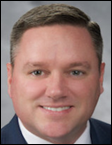Matt Roberts is global practice lead, healthcare industry of Juniper Networks of Sunnyvale, CA.

Tell me about yourself and the company.
I’ve been in healthcare IT for over 20 years. Right out of college, I started working in network closets, doing desktop rollouts as part of an internship with Health Midwest back in 2000. I was supporting one of the first Cerner Millennium projects in Kansas City, which led to them offering me a job that I accepted. I worked for Cerner for 10 years, living in hospitals and clinics. I helped them set up one of the first HIEs at the Tiger Institute at University of Missouri. I had an offer come my way to take my healthcare expertise over to the networking industry and I joined a company called Brocade. I led their healthcare go-to-market for roughly six years before we were acquired.
I’m now at Juniper, which is a pure play networking and security company. We are absolutely focused on delivering simple and secure experiences for those who run the networks, and even more importantly, the patients, the clinicians, and the staff who depend on the network.
What are the biggest network challenges of health systems?
We see a lot of Band-Aided networks. I’m a big fan of treating the cause, not the symptom, so when we look at what happened through the pandemic, there was a lot of stress. It was a dark place for all of us. We all have our own experiences, but it was tough. Through tough, we find ways to innovate.
During this time, many providers discovered that their network should have, and could have, been a more strategic asset, probably more so than originally perceived. We walk up to a water faucet, we turn it on, and we expect water to come out. That was the perception of the network. Until it goes down, nobody really cares. But we have seen the whole delivery model shift, so we have moved to a more virtual model and distributed model, Everything is Internet of Things.
As things continue to shift, you have to take a look at the network. It has become more important. A healthy network puts the organization in a position to scale, to integrate emergent technologies. The chief nursing officer walks in and says, “I need this technology connected today.” IT has always been a “no” center. It has to become a “yes” center and say, “We are going to be able to accommodate that for you and figure out how to integrate it into the workflows.”
How extensive is the need to re-architect health system networks due to consolidation, where new care venues of all kinds need to be brought into the connectivity fold?
Consolidation and acquisition play a major role in being able to integrate the technology seamlessly. As seamless as some of it sounds, you are also often acquiring organizations that don’t have the same standards that you have. How do you rely on integrating proprietary technologies and the way things have been architected at a technical layer from a topology standpoint? You may have to unwind some things to get that new system on board, whether it happens to be multiple hospitals or multiple clinics. It plays a critical role.
Open standards, or standards-based technologies, are important for this exact purpose. Being able to onboard quickly, to integrate seamlessly, and to provision your networks more efficiently, as opposed to having to wait weeks, months, and even sometimes years when you start to get into the project work.
Is it challenging to bring those new locations and networks up to security standards?
Yes. Security gaps are everywhere. The harsh reality is that no one vendor does it all. When you start to look holistically at the security posture of the organization, we are doing something differently at Juniper. We treat the entire network as an enforcement domain, looking at every connection point that exists within your network. It’s not just next-generation firewall, DLP, or an ATP appliance or software. Cyber criminals are getting smarter, where minutes, much less days and hours, aren’t fast enough. How do you identify and mitigate a threat immediately as it comes in?
I use the analogy of how many locks you have on your door at home. You have deadbolt, a push button, an extra lock, a Ring doorbell, and maybe a German Shepherd behind the door. You have multiple layers of different protection. When you look at your security posture, there’s not a one-all, be-all.
Healthcare is among the top industries, maybe number one, for cyber criminal activities because the information is so rich. You have to look at new ways instead of just throwing a bunch of firewalls out. Protect the entire domain and know what’s going on in the entire domain. Then be able to identify something that looks fishy and shut it down so it doesn’t propagate through the entire network.
What changed during the pandemic?
The network is the lifeblood of the healthcare enterprise, like the vascular system of the human body that pumps our blood to and from the heart. The network is your vascular and immune system. If you don’t have a healthy network, the organization is at risk. The pandemic created gaps. But we see positivity as people understand how strategic the network is. It’s not just watching how the packets pass and getting bits and bytes to their destination without latency. You have to look at the whole thing, the hard and soft costs around the economics. Are you buying the same brand because that’s all you’ve known for the last 20 years? Look at what’s fit for purpose. Look at what molds well to what your organization is trying to do. Are there better organizations out there that are leading edge about trying to help also make you more efficient?
That’s where we come in. We are focused on experiences. If you’re the IT operator, on the network or help desk teams, or an end user such as a doctor or nurse or a radiologist sitting at home, how can that network work for you? Or how can you not have to pick up the phone and call the help desk if you’ve got a really crappy connection? We are starting to see small, medium, and large entities, from smaller hospitals to larger health systems, looking at the network. It’s exciting because they are looking at newer technologies that are different from what they have done over the past 20 years.
The industry has evolved so much. It involves AI. It involves a lot of capabilities that have moved beyond the marketing hype that allow you to focus on not only delivering a 24/7/365 experience, but to put you in a position where the network is working for you versus having to dig and spend hours trying to troubleshoot issues. That’s where we can help as well.
How are organizations using indoor location services?
When I talk about location services, everything is built into our access point. Think w-fi. We use what’s called virtual Bluetooth low energy. We have a patented array that sits in the access point. We are the only one in the industry that does that. In the Gartner Magic Quadrant for indoor location services, we are in the leader quadrant far over to the right. We are the only networking vendor in that particular space.
Delivering location services is a journey, to be fair. An organization has to have a strategy around that. It starts at looking at the use case. Maybe you want to greet people as they walk in the front door and offer them a turn-by-turn indoor navigation experience because of late or missed appointments or people getting lost throughout the facility. Maybe you want to track critical medical assets because wheelchairs and pumps are getting lost – studies have found that 20 to 30% of mobile medical equipment is lost or stolen. You can deliver these location services directly off of wi-fi now instead of buying a bunch of different pieces and parts and overlay RTLS systems.
However, we integrate seamlessly with those. We’re an open standards-based company. The value for healthcare is to look at open API strategies, to look at exchanging SDKs and other software defined kits, to integrate into other entities like Stanley and CenTrak so you don’t have to do a rip and replace. Cost preservation is big in healthcare. I’ve been in healthcare 20 years and I want to save healthcare a lot of money and make it more efficient. We seeing an uptick in all the different types of location use cases to get a consumer engagement platform in place. Hospitals and health systems can engage with patients and guests while also helping their staff become more productive.
What about proximity alerts involving visitors or employees?
It is opening more opportunities. It creates this platform for IOT, but it also creates a platform for at least understanding who is coming into your facility. We don’t record PHI. We’re just looking at devices. If you walk in with a Bluetooth capable or enabled device, such as a phone, it can be detected. You see this in retail, hospitality, and a lot of different industries. We can get within one to three meters, or even closer to the one-meter mark by using BT11 devices.
That lets you understand what is happening with your facility’s foot traffic. It came more important in the heat of COVID for proximity tracing and dwell times. If a facility needs to disperse a hot zone, they can push a notification out to everybody who was congregating when they shouldn’t have been. We can do these directly out of our dashboarding capabilities and the integration work that we can do with engagement type devices over mobile.
What healthcare developments will we see in the company and the industry over the next few years?
We literally are changing the game again. The accolades are out there. Everybody can go look and see from a lot of the analyst community and industry recognitions that we truly are improving the end-to-end visibility. Insights into users, devices, and applications creates a fine-tuned experience for clinicians, patients, and the people who are running the networks.
We are dramatically simplifying the operation. Using AI to proactively notify IT when there’s a problem, provide a fix, and automatically open up trouble tickets in ServiceNow or whatever your ticketing system is. Imagine not having to chase a doctor or nurse to ask them to re-create an issue. We are eliminating all of that.
Nobody has seen this in healthcare. It’s a foreign concept, and it sounds too good to be true, but the reality is that we are changing the dynamics of how we make people more efficient. Talk about provisioning all those acquired clinics and hospitals as we mentioned before. We can use the cloud and microservices so that the AP and the switches are ready. As soon as you acquire somebody, and you have plans to basically roll out a new network, with single-click activation it literally can be plugged in as soon as you ship it to that device. Or let’s say that the clinic is two hours away and somebody can’t travel there, you can have somebody do this over distance, reducing the truck rolls, the touches, provisioning networks by 50 to 70% better.
Nobody has seen it in healthcare, and this is where we get excited. This is where I get excited sharing my message with you on what we’re doing. We are at an interesting time where people are coming out of the pandemic and doing digital transformation initiatives. The network should be considered when you start throwing all of these other things on top of it. That’s your foundation, and we want to make sure that you have the most modern foundation that is possible, one that can scale for many, many years.















































"ONC reports that 70% of hospitals engaged in all four domains of interoperability (send, receive, find, and integrate) in 2023."…